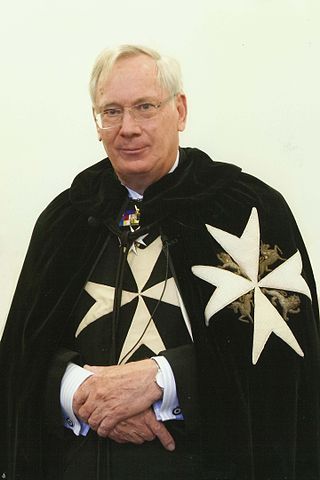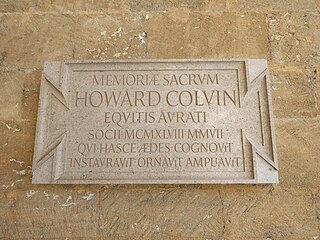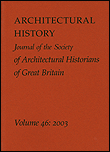Related Research Articles

Prince Richard, Duke of Gloucester, is a member of the British royal family. He is the second son of Prince Henry, Duke of Gloucester and Princess Alice, Duchess of Gloucester, as well as the youngest of the nine grandchildren of King George V and Queen Mary. He is currently 30th in line of succession to the British throne, and the highest person on the list who is not a descendant of George VI, who was his uncle. At the time of his birth, he was 5th in line to the throne, behind his first cousins Princess Elizabeth and Princess Margaret, his father, and his elder brother Prince William of Gloucester.

Sir Nikolaus Bernhard Leon Pevsner was a German-British art historian and architectural historian best known for his monumental 46-volume series of county-by-county guides, The Buildings of England (1951–74).

The American Institute of Architects (AIA) is a professional organization for architects in the United States. Headquartered in Washington, D.C., the AIA offers education, government advocacy, community redevelopment, and public outreach to support the architecture profession and improve its public image. The AIA also works with other members of the design and construction community to help coordinate the building industry.

Victorian architecture is a series of architectural revival styles in the mid-to-late 19th century. Victorian refers to the reign of Queen Victoria (1837–1901), called the Victorian era, during which period the styles known as Victorian were used in construction. However, many elements of what is typically termed "Victorian" architecture did not become popular until later in Victoria's reign, roughly from 1850 and later. The styles often included interpretations and eclectic revivals of historic styles (see Historicism). The name represents the British and French custom of naming architectural styles for a reigning monarch. Within this naming and classification scheme, it followed Georgian architecture and later Regency architecture, and was succeeded by Edwardian architecture.
An architectural design competition is a type of design competition in which an organization that intends on constructing a new building invites architects to submit design proposals. The winning design is usually chosen by an independent panel of design professionals and stakeholders. This procedure is often used to generate new ideas for building design, to stimulate public debate, generate publicity for the project, and allow emerging designers the opportunity to gain exposure. Architecture competitions are often used to award commissions for public buildings: in some countries rules for tendering public building contracts stipulate some form of mandatory open architectural competition.

The Royal Institute of British Architects (RIBA) is a professional body for architects primarily in the United Kingdom, but also internationally, founded for the advancement of architecture under its royal charter granted in 1837, three supplemental charters and a new charter granted in 1971.

The Society of Architectural Historians (SAH) is an international not-for-profit organization that promotes the study and preservation of the built environment worldwide. Based in Chicago in the United States, the Society's 3,500 members include architectural historians, architects, landscape architects, preservationists, students, professionals in allied fields and the interested public.

The Georgian Group is a British charity, and the national authority on Georgian architecture built between 1700 and 1837 in England and Wales. As one of the National Amenity Societies, The Georgian Group is a statutory consultee on alterations to listed buildings, and by law must be notified of any work to a relevant listed building which involves any element of demolition.

Sir Howard Montagu Colvin was a British architectural historian who produced two of the most outstanding works of scholarship in his field: A Biographical Dictionary of British Architects, 1600–1840 and The History of the King's Works.

Jacob Wrey Mould was a British architect, illustrator, linguist and musician, noted for his contributions to the design and construction of New York City's Central Park. He was "instrumental" in bringing the British High Victorian architecture to the United States, and was a founding member of the American Institute of Architects.
Henry-Russell Hitchcock (1903–1987) was an American architectural historian, and for many years a professor at Smith College and New York University. His writings helped to define the characteristics of modernist architecture.

Joseph Mordaunt Crook,, generally known as J. Mordaunt Crook, is an English architectural historian and specialist on the Georgian and Victorian periods. He is an authority on the life and work of the Victorian architect William Burges, his biography published in 1981, and reissued in 2013, has been described as "one of the most substantial studies of any Victorian architect".
Turpin Chambers Bannister was one of the leading American architectural historians of his generation. A long-time professor at the University of Illinois and the University of Florida, he is best known for his work in architectural history, including his work with The Society of Architectural Historians, and editorship of The Journal of the Society of Architectural Historians.
Gavin Mark Stamp was a British writer, television presenter and architectural historian.

John Buckler, Snr was a British artist and occasional architect who is best remembered for his many drawings of churches and other historic buildings, recording much that has since been altered or destroyed.

Architectural History is an annual peer-reviewed journal published by the Society of Architectural Historians of Great Britain (SAHGB).
The Chartered Institute of Architectural Technologists (CIAT) is the qualifying body for architectural technology, primarily in the United Kingdom but also internationally. The institute has members in overseas centres such as Hong Kong and the Republic of Ireland. 'Chartered Architectural Technologist' is a protected title listed in the European Directive 2005/36/EC. Chartered Members of the Institute may use the designation MCIAT and the title of Chartered Architectural Technologist. CIAT is a member of AEEBC.
The London Society is a British membership organisation established to encourage public interest and participation in urban planning and transport matters in London as well as to study and celebrate the capital's unique history and character. It is among the oldest civic societies in the United Kingdom.
Elain Harwood is an architectural historian with Historic England and a specialist in post-Second World War English architecture.
David Edward Hemsoll FSA is a British art and architectural historian, specialising in Renaissance art and architecture, especially that of Rome, Florence, and Venice. He has published numerous catalogue essays and books that address architectural theory and the methodology of architectural design. He is currently (2020) Senior Lecturer in the Department of Art History, Curating and Visual Studies at the University of Birmingham.
References
- ↑ About US, Society of Architectural Historians of Great Britain.
- ↑ The Society of Architectural Historians of Great Britain Archived 2008-12-06 at the Wayback Machine , RIBApedia.
- ↑ Society of Architectural Historians of Great Britain, Open Library.
- ↑ Publications: Architectural History Archived 2011-03-11 at the Wayback Machine , Society of Architectural Historians of Great Britain.